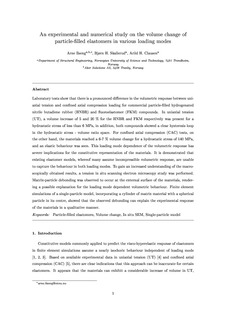| dc.contributor.author | Ilseng, Arne | |
| dc.contributor.author | Skallerud, Bjørn Helge | |
| dc.contributor.author | Clausen, Arild Holm | |
| dc.date.accessioned | 2017-11-10T14:33:04Z | |
| dc.date.available | 2017-11-10T14:33:04Z | |
| dc.date.created | 2017-01-19T09:12:14Z | |
| dc.date.issued | 2017 | |
| dc.identifier.citation | Mechanics of materials (Print). 2017, 106 44-57. | nb_NO |
| dc.identifier.issn | 0167-6636 | |
| dc.identifier.uri | http://hdl.handle.net/11250/2465605 | |
| dc.description.abstract | Laboratory tests show that there is a pronounced difference in the volumetric response between uniaxial tension and confined axial compression loading for commercial particle-filled hydrogenated nitrile butadiene rubber (HNBR) and fluoroelastomer (FKM) compounds. In uniaxial tension (UT), a volume increase of 5% and 20% for the HNBR and FKM respectively was present for a hydrostatic stress of less than 6 MPa, in addition, both compounds showed a clear hysteresis loop in the hydrostatic stress - volume ratio space. For confined axial compression (CAC) tests, on the other hand, the materials reached a 6–7% volume change for a hydrostatic stress of 140 MPa, and an elastic behavior was seen. This loading mode dependence of the volumetric response has severe implications for the constitutive representation of the materials. It is demonstrated that existing elastomer models, whereof many assume incompressible volumetric response, are unable to capture the behavior in both loading modes. To gain an increased understanding of the macroscopically obtained results, a tension in situ scanning electron microscopy study was performed. Matrix–particle debonding was observed to occur at the external surface of the materials, rendering a possible explanation for the loading mode dependent volumetric behavior. Finite element simulations of a single-particle model, incorporating a cylinder of matrix material with a spherical particle in its center, showed that the observed debonding can explain the experimental response of the materials in a qualitative manner. | nb_NO |
| dc.language.iso | eng | nb_NO |
| dc.publisher | Elsevier | nb_NO |
| dc.rights | Attribution-NonCommercial-NoDerivatives 4.0 Internasjonal | * |
| dc.rights.uri | http://creativecommons.org/licenses/by-nc-nd/4.0/deed.no | * |
| dc.title | An experimental and numerical study on the volume change of particle-filled elastomers in various loading modes | nb_NO |
| dc.type | Journal article | nb_NO |
| dc.type | Peer reviewed | nb_NO |
| dc.description.version | acceptedVersion | nb_NO |
| dc.source.pagenumber | 44-57 | nb_NO |
| dc.source.volume | 106 | nb_NO |
| dc.source.journal | Mechanics of materials (Print) | nb_NO |
| dc.identifier.doi | 10.1016/j.mechmat.2017.01.007 | |
| dc.identifier.cristin | 1431598 | |
| dc.description.localcode | © 2017. This is the authors’ accepted and refereed manuscript to the article. LOCKED until 12.1.2019 due to copyright restrictions. This manuscript version is made available under the CC-BY-NC-ND 4.0 license http://creativecommons.org/licenses/by-nc-nd/4.0/ | nb_NO |
| cristin.unitcode | 194,64,45,0 | |
| cristin.unitname | Institutt for konstruksjonsteknikk | |
| cristin.ispublished | true | |
| cristin.fulltext | postprint | |
| cristin.qualitycode | 1 | |

